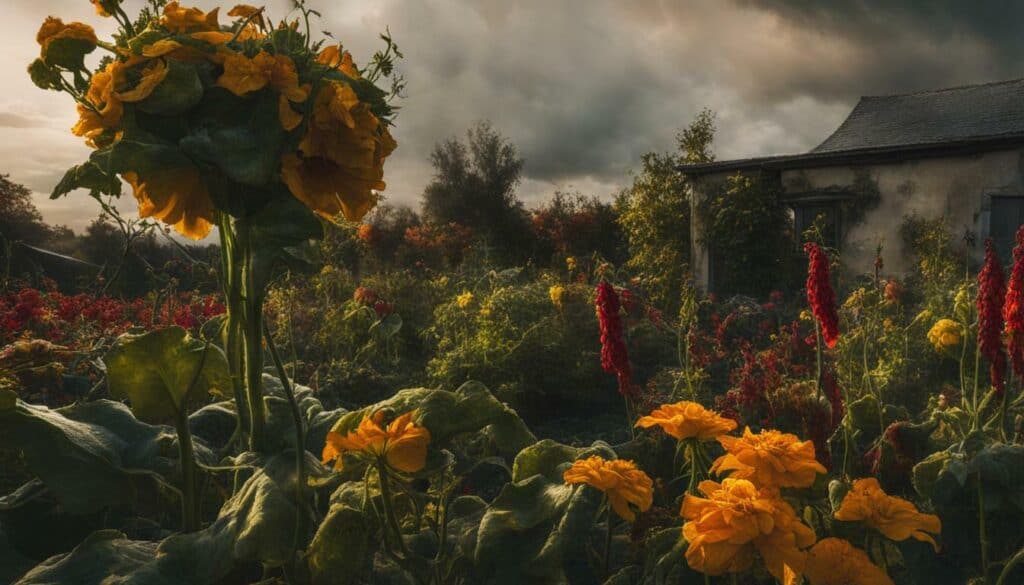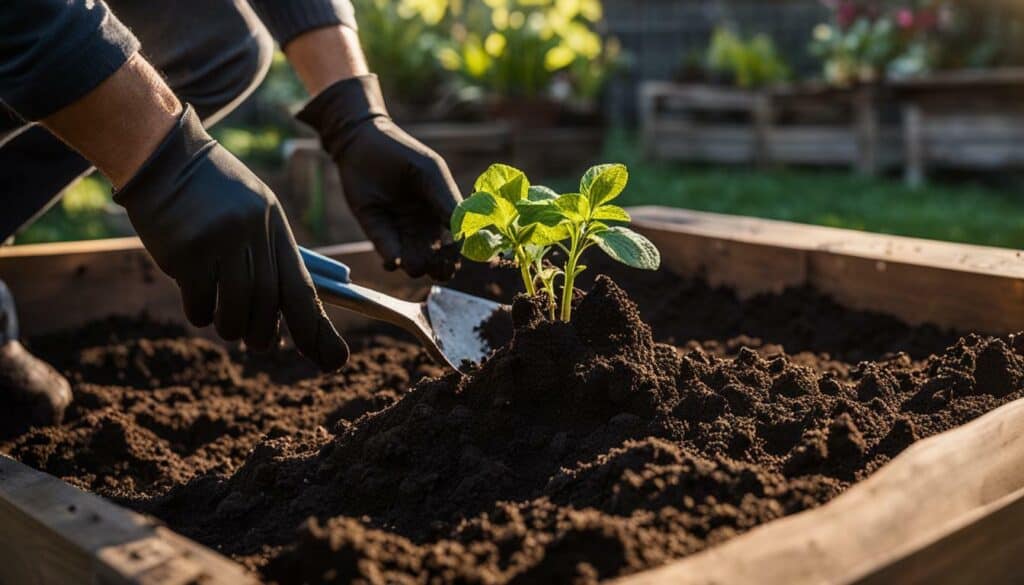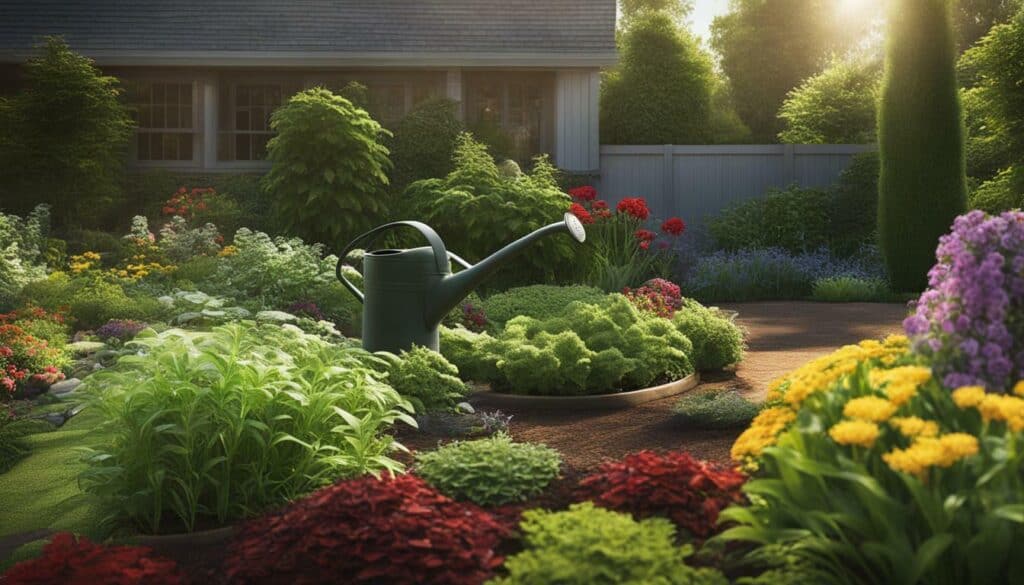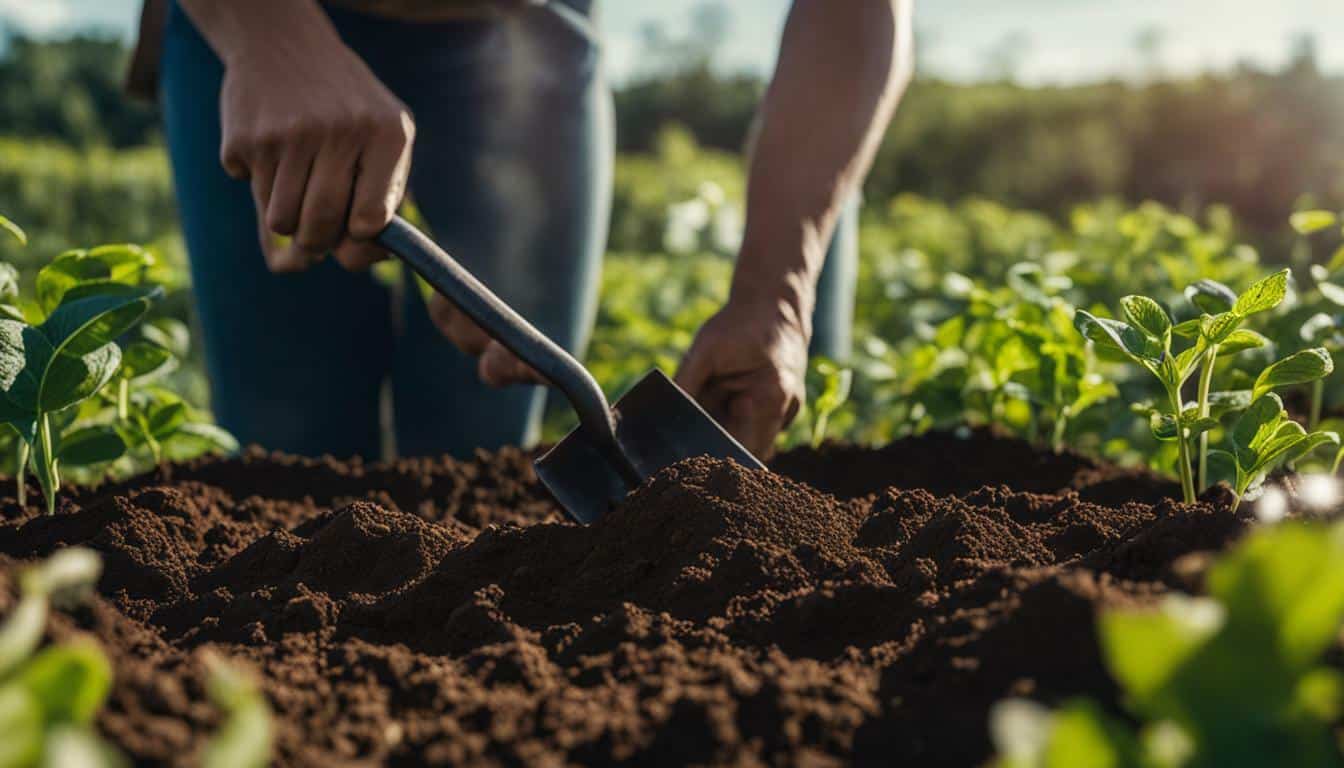Master Gardening Basics: A Beginner’s Friendly Guide is about finding the right combination of sunlight, fertile soil, and water to make plants thrive. As a beginner, gardening can seem overwhelming and technical, but with the right knowledge and approach, anyone can create a beautiful, thriving garden. In this guide, we will cover essential gardening techniques, tips for starting a garden, and caring for it successfully.
Key Takeaways:
- Successful gardening requires a combination of sunlight, fertile soil, and water
- As a beginner, understanding gardening basics, pest management, and how to grow different types of plants is essential
- Investing in a gardening library and finding reliable gardening information online can be helpful
- Knowing your gardening zone, having the right tools and supplies, and finding the right location for your garden are important factors to consider
- Soil quality is crucial to successful gardening and preparation and amendment with compost and leaf mold can be beneficial
- Effective planting and necessary supplies and steps are crucial for successful planting and care
Understanding Sunlight, Soil, and Water Requirements
To master gardening basics, it’s crucial to understand the specific sunlight, soil, and water requirements for different plants. As a beginner, you can start by choosing plants that are native to your area or hardy perennials that can withstand local weather conditions. To ensure successful gardening, it’s important to learn how to choose the right location, amend the soil, and properly water your plants.
Gardening for beginners: Choosing the right location is a critical factor for successful gardening. Most plants need at least six hours of sunlight to thrive, but the amount of sunlight varies depending on the type of plant. Some plants prefer full sun, while others need partial or full shade. It’s important to check the light conditions in different parts of your garden throughout the day to determine the best location for each type of plant.
| Sunlight Requirements | Light Conditions |
|---|---|
| Full Sun | 6+ hours of direct sunlight per day |
| Partial Sun/Partial Shade | 4-6 hours of direct sunlight per day |
| Full Shade | Less than 4 hours of direct sunlight per day |
Gardening fundamentals: Soil quality is another critical factor in successful gardening. Testing your soil’s pH level and nutrient content can help you understand what amendments are necessary for optimal plant growth. Adding organic matter such as compost, peat moss, or aged manure can improve soil structure and drainage. It’s important to avoid overwatering plants, as it can lead to root rot and other issues.
Beginner-friendly gardening advice: Proper watering is essential for plant health. Most plants need about one inch of water per week, either from rainfall or watering. It’s important to water deeply and infrequently, rather than a little bit every day. This helps encourage long, healthy roots that can access water deep in the soil. Mulching around plants can also help retain moisture and suppress weeds.
To become a successful gardener, it’s important to understand and apply the fundamental gardening techniques. In the next section, we’ll cover essential gardening tasks such as soil amendment, pruning, and pest control.

Essential Gardening Tasks: Soil Amendment, Pruning, and Pest Control
As a beginner, learning how to properly amend soil, prune shrubs, and handle pests and diseases is essential in maintaining a healthy garden. Soil amendment is crucial for providing plants with the necessary nutrients and moisture needed for optimal growth. Adding organic matter such as compost, leaf mold, or aged manure to soil can improve soil structure, water-holding capacity, and nutrient availability.
| Pruning Shrubs | Dealing with Pests and Diseases |
|---|---|
 |  |
| Pruning shrubs: Regular pruning of shrubs can help maintain their size and shape, promote branching, and remove dead or diseased wood. It is essential to use sharp and clean pruning tools to prevent damage to the plant and spread of diseases. | Dealing with pests and diseases: Monitoring your plants regularly for signs of pests and diseases is important for early detection and treatment. Using natural control methods such as companion planting, handpicking, or spraying a solution of water and soap can also be effective. |
Understanding common pests and diseases that affect plants in your area can help you prevent and control them. Some common pests to watch out for include aphids, spider mites, and whiteflies, while common diseases include powdery mildew, black spot, and blight. It is important to read labels carefully and follow instructions when using pesticides or fungicides.
Pruning and pest control are important gardening tasks that should not be neglected. With proper techniques and knowledge, you can maintain healthy and beautiful plants in your garden.
Growing Different Types of Plants: Vegetables, Herbs, Flowers, and Indoor Plants
Discover the joys of growing various types of plants, from vibrant flowers to fresh vegetables, and learn the specific care requirements for each. Understanding the different types of plants is crucial to their success. Annuals, perennials, shrubs, bulbs, evergreen plants, and deciduous plants have unique characteristics in terms of growth habits, size at maturity, and maintenance needs. It is also important to consider the amount of sunlight and shade a plant needs, as well as its preferred soil type and water requirements.

For those new to gardening, it is recommended to start with easy-to-grow plants, such as herbs and vegetables. Once you gain more experience and confidence, you can try growing more challenging plants, such as perennials or shrubs.
Gardening books are an excellent resource for learning about different types of plants, general gardening tips and techniques, and region-specific information. Additionally, many state cooperative extension websites offer free, scientifically-based local gardening information. Local extension offices and botanic gardens also offer courses and workshops as well as gardening advice.
Having the right tools and supplies is essential for successful gardening. Some basic tools include a garden shovel, fork, hand trowel, pruners, gloves, and a wheelbarrow. Be sure to find the right location for your garden, taking into consideration the amount of sun or shade a spot receives.
There are different methods for starting a garden, such as traditional digging, no-dig methods, or raised bed/container gardening. Soil preparation is key, which includes testing and amending the soil with compost and leaf mold. Planting involves digging a hole, preparing the plant’s roots, and planting it in the ground or in containers using appropriate soil.
Regular care and maintenance, including watering, fertilizing, pest control, and pruning, are important for the health and growth of plants. Be sure to research the specific care requirements for each type of plant you grow. Fortunately, many plants have similar care requirements, such as regular watering and adequate sunlight.
With a little knowledge and preparation, gardening can be a fulfilling and rewarding hobby. Selecting the right plants, educating oneself, having the necessary tools and supplies, and providing proper care are all crucial steps in growing a beautiful and bountiful garden.
Understanding Common Gardening Terms and Online Learning Resources
Don’t let unfamiliar gardening terms confuse you – familiarize yourself with common terms, and explore online courses to deepen your gardening skills. Some basic terms that beginners should know include:
- Annuals: plants that complete their life cycle in one year.
- Perennials: plants that come back year after year.
- Shrubs: woody plants that have multiple stems.
- Bulbs: plants that grow from an underground storage structure.
- Evergreen: plants that retain their leaves year-round.
- Deciduous: plants that lose their leaves in the fall and regrow them in the spring.
- Zone: a geographic area with a specific climate range that determines what plants will grow well there.
- Exposure: the direction that a garden faces, which affects how much sunlight it receives.
- Habit: the overall growth pattern of a plant.
- Height & spread: the maximum height and width that a plant will reach at maturity.
In addition to familiarizing yourself with these terms, online learning resources can be a great way to expand your gardening knowledge. Online courses from Joe Lamp’l, cooperative extension websites, local extension offices, and local botanic gardens are just a few examples of resources that can help you become a better gardener.
Developing a good gardening mindset is also important for success. Educate yourself, keep good records, and develop curiosity, patience, and a sense of humor. Knowing your gardening zone, having the right tools and supplies, finding the right location, starting a garden using different methods, and starting with good soil are key steps in successfully gardening. Proper planting techniques involve gathering supplies, digging a hole, preparing the plant’s roots, and planting in the ground or containers.

The Importance of Gardening Zones and Tools & Supplies
To create a thriving garden, it’s crucial to understand your gardening zone and have the right tools and supplies at your disposal. Your gardening zone is determined by the lowest average temperature in your area, and knowing your zone can help you choose plants that can withstand the climate. In the United States and Canada, there are 11 different growing zones to consider.
Investing in the right tools and supplies can make gardening tasks easier and more efficient. Essential gardening tools include pruners, shovels, and gloves. Having good-quality soil and compost is also important to improve the health and productivity of your plants. Consider the lighting conditions in your garden when selecting plants, as some require full sun while others thrive in shade.

By understanding your gardening zone and having the right tools and supplies, you can create a beautiful and productive garden regardless of your level of experience. In addition to being aesthetically pleasing, gardening also offers therapeutic benefits for the body, mind, and soul. Whether you’re a seasoned gardener or just starting, grab your tools and start enjoying the joys of gardening today.
Tips for Starting a Garden and Preparing the Soil
Ready to embark on your gardening journey? Here are some essential tips to get you started on the right foot, from selecting the perfect spot to preparing your soil:
- Educate yourself: Investing in a gardening library can be a great way to learn about the type of garden you want to grow. There is also a wealth of reliable gardening information available online, especially on your state’s cooperative extension website.
- Keep good records: Start a garden journal to track what works and what doesn’t. Taking notes, drawing sketches, and taking photos can help you document your observations and progress.
- Develop curiosity, patience, and a sense of humor: Be a curious observer in your garden and look for both problems and delights. This will help you become a better gardener and deepen your connection to nature.
- Know your gardening zone: Determining your hardiness zone can help you understand what plants you can grow and when. It can also help you identify which plants are perennial and annual in your area.
- Get the right tools and supplies: Stock up on essential gardening tools such as shovels, pruners, gloves, and wheelbarrows. Research the light conditions in your garden to choose plants that suit the available sunlight.
- Choose the right planting method: There are different methods you can use to start a garden, including removing existing sod, the no-dig method, and raised beds or container gardening. Each method has its advantages and can be tailored to your space and preferences.
- Start with good soil: Soil preparation is crucial for a healthy garden. Take soil samples and have them tested to determine the nutrients your soil needs. Amend the soil yearly with compost and leaf mold.
- Learn how to plant: Gather the necessary supplies such as a hand trowel, garden soil, and plants of your choice. Dig a hole twice the size of the plant’s rootball, gently tease the roots, and plant it in the prepared soil.
By following these tips, you will be well on your way to starting a garden and preparing the soil for successful plant growth. Happy gardening!

Planting: Techniques and Considerations
Once you’ve prepared your soil, it’s time to dig in and start planting – follow these techniques and considerations for successful plantings.
Spacing: Different plants require different spacing, so be sure to read the label or research the plant’s needs before planting. Proper spacing ensures that each plant has enough room to grow and access to adequate sunlight and nutrients.
Depth: Planting depth is also important for the health and success of your garden. As a general rule, plant seeds at a depth of 2-3 times their width and seedlings at the same depth as they were in their container.
Watering: Proper watering is essential for successful plant growth. Water plants deeply and thoroughly, but be careful not to overwater, as this can lead to root rot. It’s best to water in the morning or evening when temperatures are cooler to reduce water loss due to evaporation.
Care after planting: After planting, it’s important to care for your new seedlings properly. Be sure to keep the soil moist but not waterlogged, and protect young plants from pests and harsh weather conditions.
Consider container gardening: If you don’t have a lot of outdoor space or want to control the soil quality, consider container gardening. Many plants thrive in containers, and it allows you to move your plants around to find the best sunlight and temperature conditions.
| Plant | Spacing | Depth |
|---|---|---|
| Tomatoes | 18-36 inches apart | 2-3 inches deep |
| Lettuce | 6-12 inches apart | 1/4-1/2 inches deep |
| Carrots | 2-3 inches apart | 1/4-1/2 inches deep |

By following these planting techniques and considerations, you’ll be well on your way to creating a healthy and vibrant garden. Remember to take note of each plant’s needs and make adjustments as necessary. Happy planting!
Caring for Your Garden: Watering, Mulching, and Fertilizing
Giving proper care and attention to your garden can make all the difference – learn the essentials of watering, mulching, and fertilizing for a thriving garden.
Watering your plants can be the most important task when it comes to successful gardening. The key is to water deeply and infrequently rather than shallow and often. Give your plants a good soaking at least once a week, depending on rainfall and temperature. Make sure to water early in the morning to avoid evaporation during the heat of the day.
Mulching is another essential gardening technique. Mulch is a layer of organic material, such as shredded leaves or bark, that covers the soil around your plants. This helps to retain moisture, suppress weeds, and regulate soil temperature. A two-inch layer of mulch is ideal for most plants.
Fertilizing is the final step in caring for your garden. Proper fertilization helps to promote healthy root growth, flowers, and fruit development. There are two main types of fertilizer: organic and synthetic. Organic fertilizer is made from natural materials such as compost and manure, while synthetic fertilizer is made from chemicals. It’s important to use the right amount of fertilizer and not to over-fertilize, which can harm your plants.
Remember to always follow the instructions on the fertilizer label, and to apply it evenly to the soil around your plants. If you’re unsure about the right amount of fertilizer to use, consult with your local garden center or extension office.
By giving your garden the proper care and attention it needs, you can enjoy a beautiful and thriving outdoor space. Remember to water deeply and infrequently, mulch to retain moisture and suppress weeds, and fertilize to promote healthy growth. With these essential gardening techniques, you’ll be on your way to becoming a successful gardener in no time.

For more information on gardening fundamentals, essential gardening techniques, and beginner gardening tips, check out your state’s cooperative extension website, local extension office or nearby botanic garden. These resources offer valuable gardening information, classes, and inspiration to help you become a better gardener.
Conclusion
By mastering the gardening basics and applying the tips provided in this guide, you can turn your garden from bare to lush and enjoy the beauty of nature right at your doorstep. Whether you are a beginner or an experienced gardener, it is important to remember the fundamentals of gardening, such as soil preparation, plant care, and pest control. Understanding your gardening zone and selecting the right plants for your specific conditions is crucial for success.
To further enhance your gardening knowledge, invest in a modest gardening library and take advantage of online resources, such as cooperative extension websites. Keeping good records and developing curiosity, patience, and a sense of humor are habits of great gardeners. Starting a garden can be done in various ways, including traditional gardening, raised bed gardening, and container gardening. Good-quality soil, compost, and leaf mold are essential for healthy plant growth, and when it comes to planting, it is important to provide the right conditions and care for each plant.
Remember, gardening is a rewarding and fulfilling activity that anyone can enjoy. By following these tips and staying dedicated to learning and improving, anyone can become the gardener they’ve always wanted to be. So, get your hands dirty and start planting!
FAQ
Q: What does this guide cover?
A: This guide covers the basics of gardening for beginners, including topics such as sunlight, soil, water requirements, essential gardening tasks, growing different types of plants, common gardening terms, gardening zones, tools and supplies, starting a garden, preparing the soil, planting techniques, and caring for your garden.
Q: How can I choose the right location for my garden?
A: To choose the right location for your garden, consider the amount of sunlight the area receives, the accessibility to water sources, and the type of soil present. You’ll want to ensure your plants receive adequate sunlight and have easy access to water.
Q: How can I test and amend my soil?
A: You can test your soil’s pH level using a soil testing kit, available at most garden centers. If necessary, you can amend your soil by adding organic matter such as compost or peat moss to improve its fertility and structure.
Q: How do I deal with common pests and diseases in my garden?
A: To deal with common pests and diseases in your garden, you can use organic pest control methods such as handpicking pests, introducing beneficial insects, or using natural insecticides. It’s important to monitor your plants regularly and take action at the early signs of pest or disease infestation.
Q: What are some basic guidelines for growing vegetables, herbs, flowers, and indoor plants?
A: For growing vegetables, herbs, flowers, and indoor plants, it’s important to provide them with the right amount of sunlight, water, and nutrients. Each type of plant has specific requirements, so it’s recommended to research their individual needs and follow planting and care instructions accordingly.
Q: What are some common gardening terms I should know?
A: Some common gardening terms include annuals, perennials, compost, fertilizers, mulch, propagation, and pruning. Understanding these terms will help you better communicate and understand gardening advice and resources.
Q: Are there online courses available for further learning?
A: Yes, there are online courses available for further learning about gardening. These courses can provide in-depth knowledge, tips, and techniques to enhance your gardening skills. You can find online courses through reputable gardening websites or educational platforms.
Q: Why is understanding gardening zones important?
A: Understanding gardening zones is important because it helps you determine which plants are most suitable for your specific climate. Different plants thrive in different zones, so knowing your gardening zone will guide you in selecting the right plants for your garden.
Q: What are some essential tools and supplies for gardening?
A: Some essential tools and supplies for gardening include a trowel, pruners, garden gloves, watering can or hose, a shovel, a rake, and a wheelbarrow. These tools will assist you in various gardening tasks and make your gardening experience more efficient.
Q: What are some tips for starting a garden from scratch?
A: When starting a garden from scratch, it’s important to select a location with adequate sunlight, prepare the soil by removing any weeds or rocks, and create garden beds or containers to plant in. You can also consider starting with easy-to-grow plants and gradually expanding your garden as you gain more experience.
Q: How should I care for my garden and ensure my plants thrive?
A: To care for your garden, you should water your plants regularly, mulch around them to retain moisture and suppress weeds, and fertilize them to provide essential nutrients. It’s also important to monitor your plants for any signs of pests or diseases and take appropriate action.
What Are Some Essential Tips for Beginners in Garden Maintenance?
When starting out with garden maintenance, there are a few beginner garden maintenance tips to keep in mind. Firstly, establish a regular watering schedule to meet the specific needs of your plants. Secondly, ensure proper soil preparation by using compost and organic matter. Finally, regularly prune your plants to promote healthy growth and prevent overcrowding. These beginner garden maintenance tips will lay a solid foundation for a thriving garden.
Source Links
- https://www.gardendesign.com/how-to/
- https://simplysmartgardening.com/gardening-101-beginning-gardener/
- https://stacyling.com/gardening-101-a-guide-for-beginners/
- https://www.mastergardenersd.org/beginning-vegetable-gardening/
- https://www.bhg.com/gardening/how-to-garden/understanding-your-yard-s-sunlight/
- https://extension.okstate.edu/fact-sheets/basic-plant-care-understanding-your-plants-needs.html
- https://www.designswan.com/archives/5-essential-gardening-tasks-to-transform-your-garden.html
- https://www.thespruce.com/garden-tasks-5092677
- https://www.almanac.com/vegetable-gardening-for-beginners
- https://naturezedge.com/the-starter-guide-to-indoor-gardening
- https://www.allrecipes.com/article/beginners-guide-to-common-gardening-terms/
- https://www.gardenary.com/blog/a-beginner-s-guide-to-common-gardening-terms
- https://lettucegrowsomething.com/gardening-terminology-101-a-beginners-guide/
- https://gardengoodsdirect.com/blogs/news/all-about-planting-zones
- https://www.gardeners.com/how-to/new-hardiness-map/7887.html
- https://www.cnet.com/home/yard-and-outdoors/understanding-your-usda-hardiness-zone-and-why-itll-keep-your-plants-alive/
- https://hort.extension.wisc.edu/articles/beginning-vegetable-garden-basics-site-selection-and-soil-preparation/
- https://www.almanac.com/soil-preparation-how-do-you-prepare-garden-soil-planting
- https://www.theartofsimple.net/5-gardening-basics-for-beginners/
- https://www.bhg.com/gardening/yard/garden-care/ten-steps-to-beginning-a-garden/
- https://www.whiteflowerfarm.com/watering-mulching-fertilizing
- https://kidsgardening.org/resources/gardening-basics-garden-maintenance-weeding-mulching-and-fertilizing/
- https://growingourown.wordpress.com/6-conclusion/
- https://www.asiafarming.com/backyard-gardening-basics-tips-and-ideas-what-every-gardener-should-know





Leave a Reply